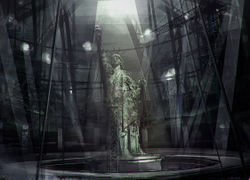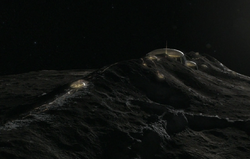Difference between revisions of "Earth"
| Line 1: | Line 1: | ||
{{wip|assign = RustySh4ckleford}} | {{wip|assign = RustySh4ckleford}} | ||
[[Image:Earth | [[Image:Earth.jpg|thumb|250px|Earth is the homeworld of humanity.]] | ||
==General Information== | ==General Information== | ||
'''System:''' [[Sol|Sol]] | '''System:''' [[Sol|Sol]] | ||
| Line 10: | Line 10: | ||
'''Capital:''' N/A | '''Capital:''' N/A | ||
'''Population (Planetside):''' | '''Population (Planetside):''' 20,160,000,000 (est.) | ||
'''Population (In Orbit):''' | '''Population (In Orbit):''' 987,950,000 (est.) | ||
Earth (also called Terra, Gaia, or Sol III) is the third planet in orbit around the star Sol, and is the homeworld of humanity. Approximately 83% of its surface is covered in salt water, due to an amplified greenhouse effect melting the planet's polar ice caps several centuries ago. Originally home to millions of distinct species of flora and fauna, it is estimated that 94% of those species have gone extinct. | Earth (also called Terra, Gaia, or Sol III) is the third planet in orbit around the star Sol, and is the homeworld of humanity. Approximately 83% of its surface is covered in salt water, due to an amplified greenhouse effect melting the planet's polar ice caps several centuries ago. Originally home to millions of distinct species of flora and fauna, it is estimated that 94% of those species have gone extinct. | ||
The biosphere of Earth was severely polluted and ecologically ravaged towards the end of the 23rd century, and a runaway greenhouse effect was nearly achieved by the time all nonrenewable resources had been depleted. However, extensive private, corporate and government investment in reclamation programs, high efficiency renewable energy and sustainable development resulted in a reversing trend of pollution that has greatly improved living conditions on the surface. | |||
Earth is the most densely populated planet in all of explored space, surpassing even the Skrellian homeworld's population by several billion. Earth is also the most developed planet in human space, with sprawling megalopolises, or "megacities." Earth also has a massive population of spacers living in orbit. Several of these superdense metropolitan areas are built up in a tiered fashion. | |||
==Geography== | ==Geography== | ||
| Line 42: | Line 46: | ||
==Society== | ==Society== | ||
[[File:Earth2457.png|300px|thumb|right|A political map showing the borders of the supranational organizations present on Earth, and the locations of megacities.]] | [[File:Earth2457.png|300px|thumb|right|A political map showing the borders of the supranational organizations present on Earth, and the locations of "megacities".]] | ||
===Humanity=== | ===Humanity=== | ||
| Line 107: | Line 111: | ||
===Heritage Sites=== | ===Heritage Sites=== | ||
[[Image:statue_of_liberty.jpg|thumb|250px|The Statue of Liberty was moved from its original location due to rises in the sea level.]] | |||
==The Moon== | ==The Moon== | ||
Revision as of 22:34, 21 April 2015
This section or article is a Work in Progress.
Assigned to: RustySh4ckleford
Please discuss changes with assigned users. If no one is assigned, or if the user is inactive, feel free to inquire on the Discord as to the status of this page.
General Information
System: Sol
Moon(s): Luna
Development level: Extremely High
Capital: N/A
Population (Planetside): 20,160,000,000 (est.)
Population (In Orbit): 987,950,000 (est.)
Earth (also called Terra, Gaia, or Sol III) is the third planet in orbit around the star Sol, and is the homeworld of humanity. Approximately 83% of its surface is covered in salt water, due to an amplified greenhouse effect melting the planet's polar ice caps several centuries ago. Originally home to millions of distinct species of flora and fauna, it is estimated that 94% of those species have gone extinct.
The biosphere of Earth was severely polluted and ecologically ravaged towards the end of the 23rd century, and a runaway greenhouse effect was nearly achieved by the time all nonrenewable resources had been depleted. However, extensive private, corporate and government investment in reclamation programs, high efficiency renewable energy and sustainable development resulted in a reversing trend of pollution that has greatly improved living conditions on the surface.
Earth is the most densely populated planet in all of explored space, surpassing even the Skrellian homeworld's population by several billion. Earth is also the most developed planet in human space, with sprawling megalopolises, or "megacities." Earth also has a massive population of spacers living in orbit. Several of these superdense metropolitan areas are built up in a tiered fashion.
Geography
Landmasses
- North America
- South America
- Eurasia
- Africa
- Australia/Oceania
- Antarctica
Major Bodies of Water
- Pacific Ocean
- Atlantic Ocean
- Indian Ocean
- Arctic Ocean
- Southern Ocean
Environment
Extinctions
Global Warming
Reclamation Projects
Society
Humanity
Supranational Organizations
- North American Federation
- South American Alliance
- South African Collective
- Free African Nations
- Collective of Independent Caribbean States
- United Islamic Nations
- European Union
- Oceania
- Scandinavian Alliance
- Neo-Carolingian Federation
- Madagascar
- United Arab Emirates
- Pan-Asian Confederation
- New Russian Federation
Major Cities
- Portland
- San Francisco
- Los Angeles
- Dallas
- Las Vegas
- Mexico City
- Chicago
- Montreal
- New York City
- Washington D.C.
- Bogota
- Lima
- Rio de Janeiro
- Sao Paulo
- Buenos Aires
- Madrid
- Reykjavik
- Oslo
- Berlin
- Paris
- Rome
- Cairo
- Jerusalem
- Cape Town
- Dubai
- Karachi
- New Delhi
- Mumbai
- Bangkok
- Kuala Lumpur
- Beijing
- Shanghai
- Tokyo
- Jakarta
- Perth
- Cairns
- Brisbane
- Sydney
- Canberra
- Melbourne
- Dublin
- London
Heritage Sites
The Moon
Star System: Sol
Parent Planet: Earth
Development level: Medium; Advanced, interconnected Biodomed Cities; Pocketed with shoddily constructed Earth-slums
Capital: Harmony City
Terrestrial Population (est.): 373,674,843
Spacer Population (est.): 162,981
Noteworthy places: Lunar University of Medical Science
Luna is the moon of Earth. It is tidally locked to its parent and makes a complete revolution every 28 standard days. It formed when a rogue planetoid collided with Earth during the early stages of its formation. The moon came together from the resultant orbital debris. Luna was the first target of spacefaring humans as they pierced the outer layers of the atmosphere. It was largely ignored until the age of FTL travel and colonization, when small colonies were established, mostly as refueling and launching posts for re-entry craft.
Luna is something of a mishmash of human society. Prior to Earth's destruction, Luna was developed into an off-world hub for Earth trade and even boasted a large Resort hub. Surviving the second Sol Alliance Civil War relatively intact, Luna immediately saw an influx of refugees from Earth. The pristine, advanced biodomed cities became dotted with hastily constructed slums. Luna's economy is based around Earth orbital salvage operations, tourism and supporting the Alliance Earth Blockade. Tensions exist between the original inhabitants and the refugees, leading to the biodomes being divided up between rich and poor through the use of massive intra-dome walls. Harmony City and Heng Chang Commune have endured many riots.
Luna, being directly administered by the Alliance, democratically elects it's leaders; however, due to social tensions, the military has taken over the job of local police and some areas remain under indefinite marshal law.
Luna is also home to a number of human cultural artifacts rescued from Earth, including a significant portion of The Lourve's collection.

